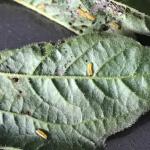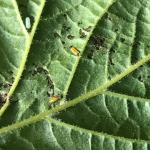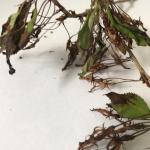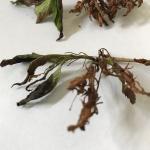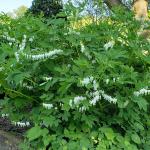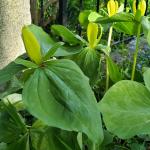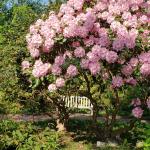UMass Extension's Landscape Message is an educational newsletter intended to inform and guide Massachusetts Green Industry professionals in the management of our collective landscape. Detailed reports from scouts and Extension specialists on growing conditions, pest activity, and cultural practices for the management of woody ornamentals, trees, and turf are regular features. The following issue has been updated to provide timely management information and the latest regional news and environmental data.
To read individual sections of the message, click on the section headings below to expand the content:
Scouting Information by Region
Environmental Data
The following data was collected on or about May 22, 2019. Total accumulated growing degree days (GDD) represent the heating units above a 50° F baseline temperature collected via our instruments for the 2019 calendar year. This information is intended for use as a guide for monitoring the developmental stages of pests in your location and planning management strategies accordingly.
|
MA Region/Location |
GDD |
Soil Temp |
Precipitation |
Time/Date of Readings |
||
|
1-Week Gain |
2019 Total |
Sun |
Shade |
|||
|
CAPE |
59 |
130 |
61 |
56 |
0.01 |
12:00 PM 5/22 |
|
SOUTHEAST |
67 |
167 |
60 |
55 |
0.16 |
3:00 PM 5/21 |
|
NORTH SHORE |
72 |
179.5 |
60 |
55 |
0.37 |
1:00 PM 5/21 |
|
EAST |
72.5 |
207 |
67 |
59 |
0.46 |
5:30 PM 5/22 |
|
METRO |
60 |
179.5 |
56 |
52 |
0.8 |
7:00 AM 5/22 |
|
CENTRAL |
72 |
204.5 |
60 |
51 |
0.35 |
1:00 PM 5/22 |
|
PIONEER VALLEY |
73.5 |
219 |
61 |
55 |
0.27 |
12:30 PM 5/22 |
|
BERKSHIRES |
62 |
192.5 |
58 |
55 |
0.36 |
10:00 AM 5/22 |
|
AVERAGE |
67 |
185 |
60 |
55 |
0.35 |
- |
n/a = information not available
Phenology
| Indicator Plants - Stages of Flowering (BEGIN, BEGIN/FULL, FULL, FULL/END, END) | ||||||||
|---|---|---|---|---|---|---|---|---|
| PLANT NAME (Botanic/ Common) | CAPE | S.E. | N.S. | EAST | METRO W. | CENT. | P.V. | BERK. |
|
Deutzia spp. (Deutzia species) |
* |
* |
* |
* |
* |
* |
* |
Begin |
|
Enkianthus campanulatus (redvein Enkianthus) |
* |
Begin/Full |
Begin |
* |
* |
* |
Begin |
Begin |
|
Rhododendron carolinianum (Carolina Rhododendron) |
Begin/Full |
Begin/Full |
Begin/Full |
Begin |
Begin |
* |
Begin/Full |
Begin |
|
Aesculus hippocastanum (common horsechestnut) |
Begin/Full |
Full |
Full |
Begin/Full |
Begin/Full |
Begin/Full |
Begin/Full |
Begin/Full |
|
Rhododendron catawbiense (Catawba Rhododendron) |
Begin |
Full |
Full |
Begin |
Begin/Full |
Begin/Full |
Begin |
Begin |
|
Elaeagnus umbellata (autumn olive) |
Begin/Full |
Full |
Full |
Begin/Full |
Full |
Full |
Full |
Begin |
|
Spiraea x vanhouttei (Vanhoutte Spirea) |
* |
Full |
* |
* |
* |
* |
Begin |
* |
|
Rhododendron spp. (early azaleas) |
Full |
Full |
Full |
Full |
Full |
Full |
Full |
Begin/Full |
|
Syringa vulgaris (common lilac) |
Full |
Full |
Full |
Full |
Full |
Full |
Full |
Full |
|
Cornus florida (flowering dogwood) |
Full |
Full |
Full |
Full/End |
Full |
Full |
Full/End |
Full |
|
Malus spp. (crabapple) |
Full |
Full |
Full |
Full/End |
Full/End |
Full/End |
End |
Full |
| * = no activity to report/information not available | ||||||||
Regional Notes
Cape Cod Region (Barnstable)
General Conditions: The average temperature during the period from May 15 – May 22 was 57˚F with a low of 42˚F on May 16 and a high of 75˚F on May 20. Overall, the period has been sunny and dry - a stark contrast to recent past weeks. The favorable work conditions are being taken advantage of by most firms which are working from dawn to dusk to catch up. Topsoil and subsoil moisture conditions remain adequate. Newly planted material should be watered due to the drying winds and bright sunlight.
Pests/Problems: Winter moth is still feeding on susceptible hosts, no defoliation is expected. Other insect pests or damage seen this week include Hydrangea leaftier on Hydrangea arborescens, Lecanium scale on oak, boxwood psyllid on boxwood, and boxwood leafminer (just about to emerge from leaves) on boxwood. The dry weather is a blessing as it will slow what was looking like a banner year for diseases. Disease symptoms or signs seen over the period include Volutella blight on boxwood, macrophoma leaf spot on boxwood, Iris leaf spot on Iris, coral spot nectria canker on Acer palmatum, brown rot on Prunus spp., anthracnose on dogwood, and anthracnose on sycamore. Numerous white pines in the upper Cape region developed winterburn-like symptoms over the last week, especially those with south facing exposures. Weeds in bloom include mouse ear chickweed (Cerastium vulgatum), dandelion (Taraxacum officinale),garlic mustard (Alliaria petiolata), ivy leaf speedwell (Veronica hederifolia), common blue violet (Viola papilionacea), creeping Charlie (Glechoma hederacea), old field cinquefoil (Potentilla simplex), cypress spurge (Euphorbia cyparissias) and yellow rocket (Barbarea vulgaris). Crabgrass has begun to germinate.
Southeast Region (New Bedford)
General Conditions: Warmer days are here. Day temperatures have been in the 60’s and 70’s. Evening temperatures dipped down to 41˚F. It looks as though it’s safe to put out our tender annuals with the disclaimer to keep an eye on night temperatures. This week’s rainfall only amounted to 0.16”, so keep an eye on newly planted trees and transplanted plant material, they may need supplemental watering. Syringa and Quercus are in full bloom. Warmer season bulbs like Alliums are also beginning to reach full bloom with these mild, sunny days. Butterflies are active.
Pests/Problems: Dandelions and cress are going to seed. Garlic mustard is flowering. Slugs and snails are active on Hosta. Ticks, mosquitoes and blackflies are active. Boxwoods are covered in aphids and Hemlock Woolly Adelgid is active.
North Shore (Beverly)
General Conditions: Seasonable spring weather continued during this reporting period. Most of the days during this period were beautiful with clear sunny skies. Only three days were overcast with light rain showers. Temperatures during this reporting period were variable with most day temperatures ranging from a low of 60˚F to the high 60s. The highest temperature during this reporting period, 83˚F, was recorded on May 20. Night temperatures were mostly in the low 50s except on May 20th when the temperature did not go below 66˚F. Approximately 0.37 inches of rainfall was recorded at Long Hill during this period. Lawns are green and there is plenty of color in the landscape. Woody plants seen in bloom include: silver bell (Halesia carolina), Wright Viburnum (Viburnum wrightii), handkerchief or dove tree (Davidia involucrata), hardy orange (Poncirus trifoliata), beach plum (Prunus maritima), large Fothergilla (Fothergilla major), dwarf Fothergilla (Fothergilla gardenii), Wisteria (Wisteria floribunda), pearlbush (Exochorda racemosa), redvein Enkianthus (Enkianthus campanulatus), flowering dogwood (Cornus florida), redbud (Cercis canadensis), little leaf lilac (Syringa microphylla), common lilac (Syringa vulgaris), common horse chestnut (Aesculus hippocastanum), Carolina Rhododendron (Rhododendron carolina), Catawba Rhododendron (Rhododendron catawbiense), crabapple (Malus spp.), and highbush blueberry (Vaccinium corymbosum). Herbaceous plants seen in bloom include: honesty plant (Lunaria annua), yellow archangel (Lamiastrum galeobdolon), blue eyed Mary (Omphalodes verna), Vinca vine (Vinca major), water forget-me-not (Myosotis palustris), barrenwort (Epimedium rubrum), Trilliums (Trillium spp.), Corydalis (Corydalis lutea), bleeding heart (Dicentra spectabilis), rue Anemone (Anemonella thalictroides), and tulips (Tulipa spp.)
Pests/Problems: The larvae of Viburnum leaf beetle (Pyrrhalta viburni) are getting larger and starting to cause damage on the leaves of susceptible Viburnum cultivars. Leaves are starting to get skeletonized. Some type of foliar blight, perhaps anthracnose, was observed on a weeping cherry tree. Weeds seen in bloom include: dandelion (Taraxacum officinale), ground ivy (Glechoma hederacea), purple deadnettle (Lamium purpureum) and blue violet (Viola spp.). Due to the relatively warmer temperatures, ticks and mosquitoes are very active. Make sure you apply repellents before going to work outdoors. Make sure you also remove any standing water to prevent mosquito breeding areas.
East Region (Boston)
General Conditions: Over the past week we received several cool damp days including the tenth consecutive Friday with precipitation. We received 0.46 inches of rain over the last seven days. Temperatures varied with a daytime low of 59˚F on the 15th and a high of 86˚F on the 20th. We gained 72.5 GDDs over the past week, bringing us to 207 for this year’s total so far. Plants are putting on lush growth and much is in bloom throughout the landscape. Many dogwoods, lilacs, Rhododendrons and Viburnums are in flower. Pollinators are active.
Pests/Problems: Winter moth caterpillars are feeding on susceptible hosts. Viburnum leaf beetle larvae continue to feed. Ground ivy (Glechoma hederaceae), creeping buttercup (Ranunculus repens) and dandelion (Taraxacum officianale) are flowering.
Metro West (Acton)
General Conditions: Typical spring-like temperatures continued into this reporting period. It was cold, hot, windy and wet on any given day. The highest temperature recorded for this week was 85°F on the 20th and the lowest temperature recorded was 40°F on the 16th. The average monthly rainfall for May is 4.04” and as of the 21st, I have recorded 2.79” of rain. Much is in bloom at this time of the year, including the following woody plants: Aesculus hippocastanum (horsechestnut), Aronia arbutifolia (black chokecherry), Cercis canadensis (redbud), Cornus florida (dogwood), Daphne x burkwoodii 'Carol Mackie' (Daphne), Fothergilla gardenii (dwarf Fothergilla), F. major (large Fothergilla), Halesia carolina ‘Arnold Pink’ (Arnold pink silverbell), Halesia tetraptera (mountain silverbell), Ilex aquifolium (English holly), Kerria japonica (Japanese Kerria), Leucothoe axillaris (coast leucothoe), Magnolia 'Elizabeth' (Elizabeth Magnolia), Malus spp. (apple, crabapple), Prunus japonica (flowering almond), P. serotina (black cherry), Rhododendron spp. (Rhododendron/azalea, including R. vaseyii - pink shell azalea), Sorbus aucuparia (European mountain ash), Spiraea spp. (bridal wreath), Syringa spp. (early-mid blooming lilac), Syringa vulgaris (common lilac), Vaccinium angustifolium (lowbush blueberry), V. corymbosum (highbush blueberry), Viburnum x burkwoodii (Burkwood Viburnum), Viburnum x juddii (Judd Viburnum) and Viburnum plicatum var. tomentosum (doublefile Viburnum).
Contributing even more color and interest to the landscape are some flowering herbaceous plants and spring ephemerals including: Actaea pachypoda (white baneberry), Ajuga reptans (bugleweed), Allium spp. (ornamental flowering onion), Amsonia hubrichtii (Arkansas blue star), Aquilegia canadensis (columbine), Arisaema triphyllum (Jack-in-the-pulpit), Aurinia saxatilis (basket of gold), Camassia scilloides (wild Hyacinth), Chrysogonum virginianum (green and gold), Convallaria majalis (lily of the valley), Dicentra eximia (fringed bleeding heart), D. spectabilis (old fashioned bleeding heart), D. spectabilis 'Alba' (white flowering old fashioned bleeding heart), Dictamnus albus (gas plant), Epimedium x 'Sulphureum' (yellow flowering barrenwort), Gallium odorata (sweet woodruff), Geranium maculatum (wild geranium), G. macrorrhizum (bigroot geranium), Hyacinthoides hispanica (wood Hyacinth), Iberis sempervirens (evergreen candytuft), Iris cristata (crested Iris), I. germanica (bearded Iris), Linaria annua (money plant), Mertensia virginica (Virginia bluebells), Muscari sp. (grape Hyacinth), Myosotis sylvatica (woodland forget-me-not), Narcissus spp. (daffodil), Nepeta spp. (ornamental catmint), Omphalodes verna (blue-eyed Mary), Phlox x subulata (moss phlox), P. divaricata (Canadian Phlox), P. stolonifera (creeping Phlox), Podophyllum peltatum (Mayapple), Polemonium reptans (Jacob’s ladder), Polygonatum commutatum (great Solomon’s seal), P. odoratum 'Variegatum' (variegated Solomon’s seal), Primula spp. (primrose), Salvia nemerosa (Salvia), Stylophorum diphyllum (wood/celandine poppy), Tiarella cordifolia (foam flower), Trillium erectum (red flowering Trillium), T. grandiflorum (white flowering Trillium), Tulipa spp. (tulip), Veronica umbrosa 'Georgia Blue' (speedwell), Vinca minor (periwinkle/myrtle), Viola spp. (violet), and Waldsteinia ternata (barren strawberry).
Pests/Problems: Observed in the landscape this past week were the following: caterpillars feeding on the leaves of Cercis (redbud) and Corylus (filbert), anthracnose on Platanus (sycamore), and leaf spot on Malus (crabapple). Many weeds are in flower including some of the most invasive: Alliaria petiolata (garlic mustard), Elaeagnus umbellata (autumn-olive), and Euonymous alatus (burning bush). Toxicodendron radicans (poison ivy) continues to leaf out and it is fairly easy to detect its shiny red leaves of three. Ticks, mosquitoes and black flies are feeding and active.
Central Region (Boylston)
General Conditions: It seems like we’re finally out of the cool, damp pattern we’ve been stuck in all spring. The warmer temperatures certainly pushed a lot of blooms this week. Overnight, many Rhododendrons and other flowering shrubs have burst to life. Vaccinium corymbosum (highbush blueberry) and V. angustifolium (lowbush blueberry) are in full bloom, as are Fothergilla gardenii (dwarf Fothergilla) and Fothergilla major (standard Fothergilla). Fortunately, the cool nights have allowed the bulb displays to linger. The last of the daffodils and tulips will likely finish up this week, making way for summer annuals.
Pests/Problems: Gypsy moths are getting larger and foliar damage is now evident on target tree species. See insect report below for details.
Pioneer Valley Region (Amherst)
General Conditions: Conditions quickly changed in the Pioneer Valley since our last report. According to the Northeast Regional Climate Center, from 5/1 to 5/15 temperatures were 2–4°F below average throughout much of Franklin, Hampshire and Hampden Counties. High temperatures swung from unseasonably cool (51–55°F from 5/12 through 5/14) to unseasonably warm (77–85°F from 5/18 through 5/20) in just a few days. Trees and shrubs in the landscape responded immediately to the warm temperatures with rapid growth of leaves and shoots delayed by the cool weather. After our warmest day of the year so far on 5/20, when temperatures reached the middle 80s, a cold front swept through the region and brought strong sustained winds >20 mph and frequent gusts >30 mph on 5/21. The Valley received only minimal rainfall during the third week of May, a welcome departure from our spring season to date. Overall, the landscape is vibrant and beautiful at this time, with few symptoms of disease or insect pressure. Of course, many foliar and shoot blight pathogens are actively infecting plants, with symptom development coming in the weeks and months ahead.
Pests/Problems: It should be painfully clear at this time which branches and shoots on Rhododendron are dead with no hope of recovery. Why some plants were horribly injured and others, in seemingly similar locations, avoided major dieback is hard to explain. However, if the shoots survived and the buds have flowered (or will shortly) but older leaves are winter-damaged, prune out just the injured leaves. Use your best judgement but generally any leaf with more than 25% of its surface area damaged can be removed. Several opportunistic foliar and shoot blight pathogens (Pestalotiopsis, Phyllosticta and Phomopsis) can occupy this dead tissue and subsequently spread if left to persist in the canopy in high numbers. Additionally, the injured foliage reduces the aesthetic value of the plants. We can also add rose-of-Sharon to the list of woody shrubs damaged by cold and wind from this past winter. Gypsy moth feeding continues but damage remains minimal on trees being regularly monitored on the UMass campus. Forest tent caterpillar can be also found right now but feeding injury from this native pest is minimal. Blue, white and Oriental spruce are flushing new growth at this time and these tender new needles are susceptible to infection by Rhizosphaera. The fungus is capable of infecting new and older needles and the spores can remain viable for weeks on dry needles until a wetting event provides the necessary moisture for germination and invasion. Given the sheer magnitude of inoculum in the landscape and the number of declining trees, intervention is likely not worth the time and money for many trees. Prune out lower canopy branches to improve air flow and aesthetics. We are now entering the time when white pine needle blight becomes most apparent on landscape and forest trees. From late May through mid- to late-June, premature needle shedding and spore dispersal from fungal pathogens reaches its zenith. Newly developing needles are highly susceptible to infection as they elongate. Several pathogens are responsible for white pine needle blight, but Lecanostica acicola and Septorioides strobi are the most abundant in our region.
Berkshire Region (Great Barrington)
General Conditions: After the very cool and wet conditions of April and most of May, conditions began to improve dramatically over the past week. Temperatures from May 15 through May 18 were about normal but on the 19th temperatures soared into the 80s. A high of 85˚F was measured at this monitoring site in West Stockbridge. Temperature that day at the Pittsfield Airport reached 82˚F. It was also a relatively dry period as well, since only 0.36 inches of rain was measured from May 15 through May 22. As a result, soils have finally begun to dry enough to be worked, though soil below the top inch of soil is still quite moist. Plant growth, i.e. leaf development and flower appearance, has accelerated. With lilacs, crabapples, Carolina silverbell, American dogwood, redbud, early Viburnums, and early azaleas in bloom, the landscape is very colorful and vibrant. Turfgrass is growing rapidly and the frequency of mowing may increase.
Pests/Problems: Euonymus scale females are now laying eggs on the undersides of leaves. Imported willow leaf beetle adults are now active on the foliage of willows. Boxwood leaf miner remains in the larval stage, however there is no sign yet of boxwood psyllid. Eastern tent caterpillars are about an inch long at this time and their feeding damage to foliage of crabapples is quite apparent. Their webbed nests are huge and loaded with their droppings. Also noticeable now, in the form of small holes in Viburnum leaves, is the damage caused by Viburnum leaf beetles. The tiny spruce spider mites can still be found on dwarf Alberta spruce. Deer tick populations are high and almost everyone who has spent any time outdoors has picked up a few of the ticks. Spraying clothing with permethrin is recommended by some physicians as a means of protecting oneself from ticks. Of course, reading and following label instructions is important. A few diseases were observed for the first time this season. These include Weir’s cushion rust on spruce, cedar-apple rust on crabapples, and wilt of new shoots of ‘Black Lace’ elderberry (Sambucus nigra). Fire blight on sand cherry continues to advance and apple scab is advancing on crabapples. The amount of winter-related browning of foliage of needled and broadleaf evergreens is staggering. Also spotted during this week’s scouting were frost cracks on some saplings of deciduous tree species.
Regional Scouting Credits
- CAPE COD REGION - Russell Norton, Horticulture and Agriculture Educator with Cape Cod Cooperative Extension, reporting from Barnstable.
- SOUTHEAST REGION - Kristin McCullin, Horticulturist reporting from Haskell Public Gardens, New Bedford.
- NORTH SHORE REGION - Geoffrey Njue, Green Industry Specialist, UMass Extension, reporting from the Long Hill Reservation, Beverly.
- EAST REGION - Kit Ganshaw & Sue Pfeiffer, Horticulturists reporting from the Boston area.
- METRO WEST REGION – Julie Coop, Forester, Massachusetts Department of Conservation & Recreation, reporting from Acton.
- CENTRAL REGION - Mark Richardson, Director of Horticulture reporting from Tower Hill Botanic Garden, Boylston.
- PIONEER VALLEY REGION - Nick Brazee, Plant Pathologist, UMass Extension Plant Diagnostic Lab, reporting from UMass Amherst.
- BERKSHIRE REGION - Ron Kujawski, Horticultural Consultant, reporting from Great Barrington.
Woody Ornamentals
Diseases
Recent pests and pathogens of interest seen in the UMass Extension Plant Diagnostic Lab https://ag.umass.edu/services/plant-diagnostics-laboratory:
Brown rot, caused by Monilinia fructicola, on Japanese flowering cherry (Prunus serrulata 'Kwanzan'). Tree is approximately 15-years-old and has been present at the site for seven years. This spring, undersized, brown and distorted shoots and leaves were observed within the interior canopy. The fungus often establishes on flowers in the spring and can attack foliage, stems and fruit. The tree resides in full sun but portions of the lower canopy are mostly shaded. Brown rot thrives in wet and shaded settings on all members of genus Prunus. Maintaining sunlight within the entire canopy is essential for disease management. The abundant rainfall in 2018 and the wet spring in 2019 have been highly conducive to disease development.
Stem cankering of a mature two-needle pine (likely Mugo pine; Pinus mugo) caused by Cenangium ferruginosum. The tree is a prostrate cultivar but is rather large, having been established at the site for more than 15 years. It was planted in full sun within a rock garden, surrounded by small groundcover plants. Significant needle browning and canopy dieback was first observed in 2018 but it was believed to be the result of winter burn. The symptoms developed again in 2019, prompting submission to the lab. Cenangium is considered an uncommon and highly opportunistic pathogen throughout the region, mostly on hard pines. Predisposition from drought is the primary means of establishment. The fungus kills cambium tissue leading to a progressive and scattered canopy dieback.
Needle blight and canopy dieback of arborvitae (Thuja occidentalis) caused by Pestalotiopsis, Phyllosticta thujae, Phomopsis and Cytospora. Numerous trees that are six- to eight-years-old and have been present at the site for four years. Planted as a screening border in a residential setting with partial sun and supplemental water from overhead lawn sprinklers. The first two pathogens (Pestalotiopsis and Phyllosticta) are very common on Thuja as needle and stem blight pathogens. But the latter two (Phomopsis and Cytospora) are not common and all four pathogens together have resulted in some significant dieback and even death. Winter burn and deer browse are also factors but the first step toward rehabilitating these trees is to end the overhead irrigation.
Phomopsis stem cankering of a 100-year-old Sargent’s weeping hemlock (Tsuga canadensis ′Pendula′). The tree was transplanted to a new location seven years ago and currently resides in full sun with drip irrigation. In spring of 2018, horticultural oil was applied and the tree has appeared healthy. However, beginning in late winter, premature needle shedding from the shoot tips was observed. Phomopsis was abundant on the submitted stems and can be regularly found causing stem cankers on young and mature eastern hemlock. While Sirococcus tsugae has received considerable attention in previous years as an important shoot blight pathogen of eastern hemlock in forest settings, it’s rarely ever encountered on submitted samples. Meanwhile, this unknown Phomopsis species appears to be an important contributor to decline and death of stressed landscape hemlocks.
Severe infestation of the elongate hemlock scale (Fiorinia externa) on Korean fir (Abies koreana). The tree is 15-years-old and has been present at the site for five years. It resides in full sun with well-drained soils. Symptoms of the infestation include chlorotic mottling on the upper surface of the foliage and premature needle shedding throughout more the half of the canopy. Infestations typically begin in the lower canopy and thus avoid detection without careful scouting. With intervention the tree can recover but it will take several years to restore vigor.
Browning and shedding of needles throughout the entire canopy of Douglas-fir (Pseudotsuga menziesii) due to Swiss needle cast (Phaeocryptopus gaeumannii), Phomopsis stem cankering and an infestation of the elongate hemlock scale (Fiorinia externa). The tree is approximately 30-years-old and has been present at the site for roughly 25 years. It’s one of many Douglas-fir trees lining a street in a residential neighborhood. All of the trees are affected with varying stages of decline exhibited at this time. Swiss needle cast is a problem for Douglas-fir alone and can be responsible for severe needle loss in forest, landscape and Xmas tree farm settings. Douglas-fir does best in New England as a solitary, isolated tree in absolute full sun. While many trees prefer and thrive in full sun, it’s an unconditional requirement for this tree species to remain healthy.
Report by Nick Brazee, Plant Pathologist, UMass Extension Plant Diagnostic Lab, UMass Amherst.
Insects
Just a Friendly Reminder:
 At this time, as always, it is important to remember that not all eggs we encounter in the landscape are from insect pests of trees and shrubs. They may be from helpful predators, such as the yellow eggs of the multicolored Asian lady beetle seen on the bark of this European hornbeam, as observed on 5/22/19 in Amherst, MA. This particular beetle is an important predator of certain aphids and scale insects and was originally introduced into the United States as a biological control agent. However, as we know, with this particular insect the legacy has been a bit of a double-edged sword. While it can be an important predator of pest insects, adults seek shelter in more comfortable areas for the winter - such as our homes - and their presence can be a nuisance to some (particularly when they come inside in large numbers). But at this time of year, we can enjoy the benefits of their impact on common landscape pests.
At this time, as always, it is important to remember that not all eggs we encounter in the landscape are from insect pests of trees and shrubs. They may be from helpful predators, such as the yellow eggs of the multicolored Asian lady beetle seen on the bark of this European hornbeam, as observed on 5/22/19 in Amherst, MA. This particular beetle is an important predator of certain aphids and scale insects and was originally introduced into the United States as a biological control agent. However, as we know, with this particular insect the legacy has been a bit of a double-edged sword. While it can be an important predator of pest insects, adults seek shelter in more comfortable areas for the winter - such as our homes - and their presence can be a nuisance to some (particularly when they come inside in large numbers). But at this time of year, we can enjoy the benefits of their impact on common landscape pests.
Woody ornamental insect and non-insect arthropod pests to consider, a selected few:

 Gypsy Moth:(Lymantria dispar) host plants include but are certainly not limited to oak (favored), maple, birch, poplar, and many others. Gypsy moth caterpillars were observed on elm and oak in Amherst, MA on 5/21 and 5/23/19. Late 2nd and early 3rd instar caterpillars were seen. During the day, 2nd instar caterpillars can be found feeding on the leaves of susceptible hosts, while the 3rd instar caterpillars may be seen (if local populations are in relatively low densities) gathered in groups on areas of the trunk or branches. In high populations, this daytime hiding behavior stops and older caterpillars will still be seen feeding on the leaves. Anecdotally, at this time, gypsy moth caterpillar densities on host plant leaves in certain areas, such as parts of Amherst, are lower than what was expected given the number of overwintering egg masses. While we have had reports of caterpillar activity and feeding across the state, we suspect that an early mortality event (that cannot yet be explained) may have occurred. While this is certainly excellent news, we should remain cautiously optimistic and continue to monitor gypsy moth populations and feeding damage, particularly in the areas mentioned below in the 2018 overwintering egg mass survey conducted by MA DCR.
Gypsy Moth:(Lymantria dispar) host plants include but are certainly not limited to oak (favored), maple, birch, poplar, and many others. Gypsy moth caterpillars were observed on elm and oak in Amherst, MA on 5/21 and 5/23/19. Late 2nd and early 3rd instar caterpillars were seen. During the day, 2nd instar caterpillars can be found feeding on the leaves of susceptible hosts, while the 3rd instar caterpillars may be seen (if local populations are in relatively low densities) gathered in groups on areas of the trunk or branches. In high populations, this daytime hiding behavior stops and older caterpillars will still be seen feeding on the leaves. Anecdotally, at this time, gypsy moth caterpillar densities on host plant leaves in certain areas, such as parts of Amherst, are lower than what was expected given the number of overwintering egg masses. While we have had reports of caterpillar activity and feeding across the state, we suspect that an early mortality event (that cannot yet be explained) may have occurred. While this is certainly excellent news, we should remain cautiously optimistic and continue to monitor gypsy moth populations and feeding damage, particularly in the areas mentioned below in the 2018 overwintering egg mass survey conducted by MA DCR.
Despite the fungal outbreak that swept through the 2017 caterpillar population, some lucky caterpillars survived to pupation and emerged as adult moths. (However, adults were present in 2017 in far fewer numbers than would have existed without the fungus.) In 2018, the Massachusetts Department of Conservation and Recreation (DCR) reported that approximately 159,705 acres were defoliated by gypsy moth caterpillars in pockets across the state. While this may seem negligible in comparison to the 923,186 acres of defoliation due to gypsy moth in 2017, for many communities the impact was still significant. MA DCR also surveyed multiple locations across the state for overwintering gypsy moth egg masses in December of 2018. They provide a map of their predictions of where pockets of defoliation may occur in 2019 based on the densities of egg masses they observed in monitored areas across the state. Many of these areas correspond with the locations previously defoliated by gypsy moth caterpillars in 2018. MA DCR predicts gypsy moth activity will occur this season in regionalized pockets of Essex, Hampden, Hampshire, Middlesex, Norfolk, Plymouth, and Worcester Counties. Maps of previous year’s defoliation as well as the 2018 overwintering gypsy moth egg mass survey may be found here, courtesy of the MA DCR: https://www.mass.gov/guides/gypsy-moth-in-massachusetts .
While it is very difficult to predict how much defoliation Massachusetts will see in 2019 due to gypsy moth caterpillar feeding, we can be certain that in areas where many egg masses overwintered, pockets of defoliation could still occur in certain areas of the state this year.
- Winter Moth: (Operophtera brumata) The winter moth population in eastern Massachusetts continues to be at record lows in most locations, and Dr. Joseph Elkinton, Professor of Environmental Conservation at the University of Massachusetts, is declaring victory over this pest! In case you have missed this news from last year, a recent edition of the UMass Magazine discusses the winter moth story and successes with the biological control of this insect (along with some fun and excellent illustrations): https://www.umass.edu/magazine/spring-2019/winter-moth .
See the Regional Reports above for current updates. Pupation of winter moth caterpillars typically occurs in late May/early June in Massachusetts, depending upon the location. Coastal areas including Cape Cod are usually a week or two behind more inland locations. Upon maturity, winter moth caterpillars will be approximately one inch in length and drop to the soil to pupate. Once pupation occurs, management of winter moth is no longer feasible.
Be sure that management of winter moth is necessary by monitoring for damaging populations before making applications in landscape settings. There may be some locations where winter moth caterpillars can be found while Cyzenis albicans catches up with the population. For more information about the life cycle and management of winter moth, please visit this fact sheet: Winter Moth Identification and Management https://ag.umass.edu/landscape/fact-sheets/winter-moth-identification-management .
Winter moth is a non-native insect that was identified in Massachusetts for the first time in 2003 following persistent reports of defoliation in eastern areas of the state such as Cape Ann and on the North Shore near Cohasset, Hingham, and Rockland on the South Shore in the late 1990’s. For more detailed information about the history of this insect pest in North America and Massachusetts, please visit this fact sheet: Winter Moth in Massachusetts: History and Biological Control https://ag.umass.edu/landscape/fact-sheets/winter-moth-in-massachusetts-history-biological-control .
- Asian Longhorned Beetle: (Anoplophora glabripennis, ALB) Look for signs of an ALB infestation which include perfectly round exit holes (about the size of a dime), shallow oval or round scars in the bark where a female has chewed an egg site, or sawdust-like frass (excrement) on the ground nearby host trees or caught in between branches. Be advised that other, native insects may create perfectly round exit holes or sawdust-like frass, which can be confused with signs of ALB activity.
The regulated area for Asian longhorned beetle is 110 miles2 encompassing Worcester, Shrewsbury, Boylston, West Boylston, and parts of Holden and Auburn. If you believe you have seen damage caused by this insect, such as exit holes or egg sites, on susceptible host trees like maple, please call the Asian Longhorned Beetle Eradication Program office in Worcester, MA at 508-852-8090 or toll free at 1-866-702-9938.
To report an Asian longhorned beetle find online or compare it to common insect look-alikes, visit: http://massnrc.org/pests/albreport.aspx or https://www.aphis.usda.gov/pests-diseases/alb/report .
- Deer Tick/Blacklegged Tick: Check out the archived FREE TickTalk with TickReport webinars available here:https://ag.umass.edu/landscape/education-events/webinars . The next live webinar will be held on October 9, 2019 with Dr. Stephen Rich of the UMass Laboratory of Medical Zoology. Previous webinars including information about deer ticks and associated diseases, American dog ticks and lone star ticks and associated diseases, ticks and personal protection, and updates from the Laboratory of Medical Zoology are archived at the link above.
Ixodes scapularis adults have been active all winter, as they typically are from October through May, and “quest” or search for hosts at any point when daytime temperatures are above freezing. Deer tick nymphs (immatures) are also active at this time, and may be encountered now through August. For images of all deer tick life stages, along with an outline of the diseases they carry, visit: http://www.tickencounter.org/tick_identification/deer_tick .
Anyone working in the yard and garden on springtime cleanup and planting should be aware that there is the potential to encounter deer ticks. The deer tick or blacklegged tick can transmit Lyme disease, human babesiosis, human anaplasmosis, and other diseases. Preventative activities, such as daily tick checks, wearing appropriate clothing, and permethrin treatments for clothing (according to label instructions) can aid in reducing the risk that a tick will become attached to your body. If a tick cannot attach and feed, it will not transmit disease. For more information about personal protective measures, visit: http://www.tickencounter.org/prevention/protect_yourself .
Have you just removed an attached tick from yourself or a loved one with a pair of tweezers? If so, consider sending the tick to the UMass Laboratory of Medical Zoology to be tested for disease causing pathogens. To submit a tick to be tested, visit: https://www.tickreport.com/ and click on the blue “Order a TickReport” button. Results are typically available within 3 business days, or less. By the time you make an appointment with your physician following the tick attachment, you may have the results back from TickReport to bring to your physician to aid in a conversation about risk.
The UMass Laboratory of Medical Zoology does not give medical advice, nor are the results of their tests diagnostic of human disease. Transmission of a pathogen from the tick to you is dependent upon how long the tick had been feeding, and each pathogen has its own transmission time. TickReport is an excellent measure of exposure risk for the tick (or ticks) that you send in to be tested. Feel free to print out and share your TickReport with your healthcare provider.
- Eastern Spruce Gall Adelgid: Adelges abietis is a pest of Norway spruce primarily, but occasionally damages other spruce species. This adelgid overwinters as a partially grown female, often referred to as a stem mother. This overwintering individual matures around bud break and lays 100-200 eggs. The eastern spruce gall adelgid may be targeted for management between 22-170 GDD’s, base 50°F.
- Eastern Tent Caterpillar: Malacosoma americanum caterpillars can be seen feeding on susceptible hosts and creating their webs (“tents”). See regional reports above for updates. Susceptible hosts include cherry and crabapple. Other host plants whose leaves are fed upon by this native insect can include apple, ash, birch, willow, maple, oak, poplar, and witch-hazel. Eastern tent caterpillars are native to Massachusetts and have many associated natural enemies (parasites and predators) that help regulate populations. Unless these caterpillars are actively defoliating specimen trees in a landscaped setting, we can coexist with this particular herbivore native to our forests.
- Elongate Hemlock Scale: Fiorinia externa is found on eastern, Carolina, and Japanese hemlock, as well as yew, spruce, and fir. Crawlers will be present this month and throughout the growing season and the overlap of many developmental stages at any given time can be observed. Treatments for the crawler, or mobile, stage of this insect may be made in late May through mid-June, or between 360-700 GDD’s, base 50°F.
- Emerald Ash Borer: (Agrilus planipennis, EAB) Since the New Year, the Massachusetts Department of Conservation and Recreation has confirmed 26 new community detections of emerald ash borer in Massachusetts. While the cities and towns with recent detections of EAB are too numerous to list here, they are in areas of Berkshire, Hampden, Hampshire, Middlesex, and Worcester counties. A map of these locations and others previously known across the state may be found here: https://ag.umass.edu/fact-sheets/emerald-ash-borer .
This wood-boring beetle readily attacks ash (Fraxinus spp.) including white, green, and black ash, has also been found developing in white fringe tree (Chionanthus virginicus), and has been reported in cultivated olive (Olea europaea). Adult insects of this species will not be present at this time of year. Signs of an EAB infested tree may include (at this time) D-shaped exit holes in the bark (from adult emergence in previous years), “blonding” or lighter coloration of the ash bark from woodpecker feeding (chipping away of the bark as they search for larvae beneath), and serpentine galleries visible through splits in the bark, from larval feeding beneath. Positive identification of an EAB-infested tree may not be possible with these signs individually on their own.
For further information about this insect, please visit: https://ag.umass.edu/fact-sheets/emerald-ash-borer . If you believe you have located EAB-infested ash trees, particularly in an area of Massachusetts not identified on the map provided, please report here: http://massnrc.org/pests/pestreports.htm .

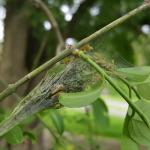 Euonymus Caterpillar: Yponomeuta cagnagella is of European origin and widespread in distribution throughout Europe. It was first reported in North America in Ontario in 1967. Still small Euonymus caterpillars continue to feed on European spindle tree foliage in Amherst, MA as observed on 5/14 and again on 5/20/2019. Caterpillars can be seen webbing foliage together, feeding, and packing that webbing full of their tiny, black frass pellets. As these caterpillars grow in size, so do their webs and entire branches may become defoliated or unsightly.
Euonymus Caterpillar: Yponomeuta cagnagella is of European origin and widespread in distribution throughout Europe. It was first reported in North America in Ontario in 1967. Still small Euonymus caterpillars continue to feed on European spindle tree foliage in Amherst, MA as observed on 5/14 and again on 5/20/2019. Caterpillars can be seen webbing foliage together, feeding, and packing that webbing full of their tiny, black frass pellets. As these caterpillars grow in size, so do their webs and entire branches may become defoliated or unsightly.
The euonymus caterpillars (larvae) feed in groups and envelop the foliage of the host plant in webs as they feed. Hosts include: Euonymus europaeus (tree form), E. kiautschovicus, E. alatus, and E. japonicus. Mature caterpillars are just under an inch in length, creamy yellow-gray in color with black spots and a black head capsule. By late June, these larvae pupate in white, oval-shaped cocoons which are typically oriented together vertically either on host plants or non-hosts in the area. Cocoons can be found in cracks and crevices, or webbed together leaves. The adult moth emerges in late June in most locations. The adult female secretes a gummy substance over her eggs which will harden, making them even more difficult to see. Eggs hatch by mid-August, at which time the tiny larvae prepare to overwinter beneath their eggshell-like covering. These larvae are inactive until the following year, when caterpillars group together to feed on newly emerging leaves, creating a mess of webs as they feed. There is one generation per year. Plants may be partially or entirely defoliated. Management of young, actively feeding caterpillars with Bacillus thuringiensis is possible if deemed necessary, however many species of Euonymus are considered invasive themselves.
- European Pine Sawfly: Neodiprion sertifer caterpillars are active roughly between 78-220 GDD, base 50°F. The primary host in MA is Mugo pine but it can be found on Scots, red, jack, and Japanese red pine, and also on white, Austrian, ponderosa, shortleaf, and pitch pine when near the aforementioned species. This dark colored caterpillar feeds in tight groups and small numbers can be pruned or plucked out of host plants and destroyed. Larger numbers can be treated with an insecticidal soap spray when the caterpillars are still small. Spinosad products can be used whenever the caterpillars are actively feeding, usually by mid-May and when caterpillars are still small. Bacillus thuringiensis kurstaki is not effective against sawflies.
 Forest Tent Caterpillar: Malacosoma disstria caterpillars were observed feeding on oak leaves in Amherst, MA on 5/14/19 and again on 5/21/19. Individuals of this native insect may be found feeding alongside gypsy moth caterpillars in the same location. Susceptible hosts whose leaves are fed on by this insect include oak, birch, ash, maple, elm, poplar, and basswood.
Forest Tent Caterpillar: Malacosoma disstria caterpillars were observed feeding on oak leaves in Amherst, MA on 5/14/19 and again on 5/21/19. Individuals of this native insect may be found feeding alongside gypsy moth caterpillars in the same location. Susceptible hosts whose leaves are fed on by this insect include oak, birch, ash, maple, elm, poplar, and basswood.
- Hemlock Looper: Two species of geometrid moths in the genus Lambdina are native insects capable of defoliating eastern hemlock, balsam fir, and white spruce. Adult moths lay their eggs on the trunk and limbs of hosts in September and October, and eggs will hatch by late May or early June. Monitor susceptible hosts for small, inch-worm like caterpillars. Where populations are low, no management is necessary.
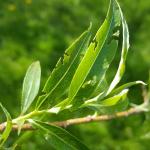
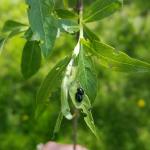
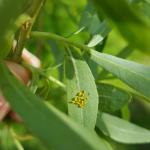 Imported Willow Leaf Beetle: Plagiodera versicolora adult beetles overwinter near susceptible hosts. A few adult imported willow leaf beetles were seen feeding on willow foliage in Chesterfield, MA on 5/11/19 and no mating or egg laying was seen at the time. By 5/22/19, it was very easy to spot adult imported willow leaf beetles feeding and mating, as well as the damage they cause to the leaves. Egg laying was also observed on 5/22/19. Adult beetles will chew holes and notches in the leaves of willow. Adult beetles mate and lay eggs through the end of this month. Females lay yellow eggs in clusters on the undersides of leaves. Larvae are slug-like and bluish-green in color. They will feed in clusters and skeletonize the leaves. Most plants can tolerate the feeding from this insect, and foliage will appear brown. Repeated yearly feeding can be an issue, in which case management of the young larvae may be necessary. Take care with treatment in areas near water.
Imported Willow Leaf Beetle: Plagiodera versicolora adult beetles overwinter near susceptible hosts. A few adult imported willow leaf beetles were seen feeding on willow foliage in Chesterfield, MA on 5/11/19 and no mating or egg laying was seen at the time. By 5/22/19, it was very easy to spot adult imported willow leaf beetles feeding and mating, as well as the damage they cause to the leaves. Egg laying was also observed on 5/22/19. Adult beetles will chew holes and notches in the leaves of willow. Adult beetles mate and lay eggs through the end of this month. Females lay yellow eggs in clusters on the undersides of leaves. Larvae are slug-like and bluish-green in color. They will feed in clusters and skeletonize the leaves. Most plants can tolerate the feeding from this insect, and foliage will appear brown. Repeated yearly feeding can be an issue, in which case management of the young larvae may be necessary. Take care with treatment in areas near water.
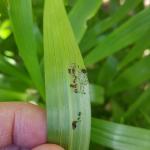
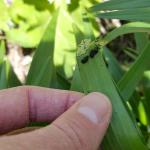 Lily Leaf Beetle: Lilioceris lilii overwintering adults have been reported by scouts in the Southeast Region previously. Adults overwintered in sheltered places and are now active with warm temperatures and available food sources. Although adult beetles were not seen during the chilly weather on 5/13/19 in Amherst, MA, previously laid eggs were located on host plant foliage in this location. As of 5/21/19, egg hatch had occurred and larvae of various sizes could be seen feeding on foliage in groups. Smaller larvae skeletonize leaves, whereas larger larvae can eat the entire leaf. As soon as susceptible hosts such as Lilium spp. (Turk’s cap, tiger, Easter, Asiatic, and Oriental lilies) and Fritillaria spp. break through the ground, the adult lily leaf beetles are known to feed on the new foliage. (Note: daylilies are not hosts.) Typically, in May, mating will occur and each female will begin to lay 250-450 eggs in neat rows on the underside of the foliage. If there are only a few plants in the garden, hand picking and destroying overwintering adults can help reduce local garden-level populations.
Lily Leaf Beetle: Lilioceris lilii overwintering adults have been reported by scouts in the Southeast Region previously. Adults overwintered in sheltered places and are now active with warm temperatures and available food sources. Although adult beetles were not seen during the chilly weather on 5/13/19 in Amherst, MA, previously laid eggs were located on host plant foliage in this location. As of 5/21/19, egg hatch had occurred and larvae of various sizes could be seen feeding on foliage in groups. Smaller larvae skeletonize leaves, whereas larger larvae can eat the entire leaf. As soon as susceptible hosts such as Lilium spp. (Turk’s cap, tiger, Easter, Asiatic, and Oriental lilies) and Fritillaria spp. break through the ground, the adult lily leaf beetles are known to feed on the new foliage. (Note: daylilies are not hosts.) Typically, in May, mating will occur and each female will begin to lay 250-450 eggs in neat rows on the underside of the foliage. If there are only a few plants in the garden, hand picking and destroying overwintering adults can help reduce local garden-level populations.
- Snowball Aphid: Neoceruraphis viburnicola becomes active on certain species of Viburnum roughly between 148-298 GDD’s or around redbud bloom. This insect is particularly noticeable on V. opulus, V. prunifolium, and V. acerifolia. Stem mothers, appearing blueish-white, can be found in curled up and distorted foliage. Damage caused by this insect pest is mostly aesthetic.
- Spotted Lanternfly: (Lycorma delicatula, SLF) is not known to occur in Massachusetts landscapes (no established populations are known in MA at this time). However, officials with the Massachusetts Department of Agricultural Resources (MDAR) recently urged residents to check plants for spotted lanternfly. On February 21, 2019 MDAR announced the discovery of a single dead spotted lanternfly adult at a private residence in Boston. As a result of this discovery, officials asked the public to check potted plants they purchase and report any suspicious insects. MDAR reports that this particular individual appeared to have been unintentionally transported this past December in a shipment of poinsettia plants originating from Pennsylvania. Officials also report that there is currently no evidence that this pest has become established in MA. For more information about this finding, please visit the MA Department of Agricultural Resources press release:https://www.mass.gov/news/state-agricultural-officials-urge-residents-to-check-plants-for-spotted-lanternfly .
This insect is a member of the Order Hemiptera (true bugs, cicadas, hoppers, aphids, and others) and the Family Fulgoridae, also known as planthoppers. The spotted lanternfly is a non-native species first detected in the United States in Berks County, Pennsylvania and confirmed on September 22, 2014.
The spotted lanternfly is considered native to China, India, and Vietnam. It has been introduced as a non-native insect to South Korea and Japan, prior to its detection in the United States. In South Korea, it is considered invasive and a pest of grapes and peaches. The spotted lanternfly has been reported from over 70 species of plants, including the following: tree of heaven (Ailanthus altissima) (preferred host), apple (Malus spp.), plum, cherry, peach, apricot (Prunus spp.), grape (Vitis spp.), pine (Pinus spp.), pignut hickory (Carya glabra), Sassafras (Sassafras albidum), serviceberry (Amelanchier spp.), slippery elm (Ulmus rubra), tulip poplar (Liriodendron tulipifera), white ash (Fraxinus americana), willow (Salix spp.), American beech (Fagus grandifolia), American linden (Tilia americana), American sycamore (Platanus occidentalis), big-toothed aspen (Populus grandidentata), black birch (Betula lenta), black cherry (Prunus serotina), black gum (Nyssa sylvatica), black walnut (Juglans nigra), dogwood (Cornus spp.), Japanese snowbell (Styrax japonicus), maple (Acer spp.), oak (Quercus spp.), and paper birch (Betula papyrifera).
The adults and immatures of this species damage host plants by feeding on sap from stems, leaves, and the trunks of trees. In the springtime in Pennsylvania (late April - mid-May) nymphs (immatures) are found on smaller plants and vines and new growth of trees and shrubs. Third and fourth instar nymphs migrate to the tree of heaven and are observed feeding on trunks and branches. Trees may be found with sap weeping from the wounds caused by the insect’s feeding. The sugary secretions (excrement) created by this insect may coat the host plant, later leading to the growth of sooty mold. Insects such as wasps, hornets, bees, and ants may also be attracted to the sugary waste created by the lanternflies, or sap weeping from open wounds in the host plant. Host plants have been described as giving off a fermented odor when this insect is present.
Adults are present by the middle of July in Pennsylvania and begin laying eggs by late September and continue laying eggs through late November and even early December in that state. Adults may be found on the trunks of trees such as the tree of heaven or other host plants growing in close proximity to them. Egg masses of this insect are gray in color and, in some ways, look similar to gypsy moth egg masses.
Host plants, bricks, stone, lawn furniture, recreational vehicles, and other smooth surfaces can be inspected for egg masses. Egg masses laid on outdoor residential items such as those listed above may pose the greatest threat for spreading this insect via human aided movement.
For more information about the spotted lanternfly, visit this fact sheet: https://ag.umass.edu/landscape/fact-sheets/spotted-lanternfly
- Spruce Spider Mite: Oligonychus ununguis is a cool-season mite that becomes active in the spring from tiny eggs that have overwintered on host plants. Hosts include spruce, arborvitae, juniper, hemlock, pine, Douglas-fir, and occasionally other conifers. This particular species becomes active in the spring and can feed, develop, and reproduce through roughly June. When hot, dry summer conditions begin, this spider mite will enter a summer-time dormant period (aestivation) until cooler temperatures return in the fall. This particular mite may prefer older needles to newer ones for food. When damaging spruce spider mite populations are known from last season, dormant oil applications can be made (when temperatures are appropriate according to label instructions) between 7-121 GDD’s, base 50°F. Magnification is required to view spruce spider mite eggs. Tapping host plant branches over white paper may be a useful tool when scouting for spider mite presence. (View with a hand lens.) Spider mite damage may appear on host plant needles as yellow stippling and occasionally fine silk webbing is visible.
- Viburnum Leaf Beetle: Pyrrhalta viburni is a beetle in the family Chrysomelidae that is native to Europe, but was found in Massachusetts in 2004. See Regional Reports above for updates regarding the activity of this pest. This beetle feeds exclusively on many different species of Viburnum, which includes, but is not limited to, susceptible plants such as V. dentatum, V. nudum, V. opulus, V. propinquum, and V. rafinesquianum. Larvae, when they are present, may be treated with a product containing spinosad once they appear. Some Viburnum have been observed to have varying levels of resistance to this insect, including but not limited to V. bodnantense, V. carlesii, V. davidii, V. plicatum, V. rhytidophyllum, V. setigerum, and V. sieboldii. More information about Viburnum leaf beetle may be found at http://www.hort.cornell.edu/vlb/ .
- White Spotted Pine Sawyer (WSPS): Monochamus scutellatus will be pupating this month and adults can emerge in late May throughout July, depending on local temperatures. This is a native insect in Massachusetts and is usually not a pest. Larvae develop in weakened or recently dead conifers, particularly eastern white pine (Pinus strobus). However, the white spotted pine sawyer looks very similar to the invasive Asian Longhorned Beetle, Anoplophora glabripennis, ALB. ALB adults do not emerge in Massachusetts until July and August. Beginning in July, look for the key difference between WSPS and ALB adults, which is a white spot in the top center of the wing covers (the scutellum) on the back of the beetle. White spotted pine sawyer will have this white spot, whereas Asian longhorned beetle will not. Both insects can have other white spots on the rest of their wing covers; however, the difference in the color of the scutellum is a key characteristic. See the Asian longhorned beetle entry above for more information about that non-native insect.
- Woolly Apple Aphid: Eriosoma lanigerum may be found on apple, crabapple, hawthorn, mountain-ash, Pyracantha, and elm hosts. The primary (winter) host is elm, on which aphids infest emerging spring leaves, causing leaves to curl or close into stunted, rosette-like clusters found at twig tips. Woolly apple aphid was observed on elm on 5/13/2019 in Amherst, MA. On apple and crabapple, this species of aphid colonizes roots, trunks, and branches in the summer and is commonly found near previous wounds or callous tissue. On roots, the aphids cause swelled areas which can girdle and kill roots. The aphids, when found in above ground plant parts such as elm leaves are covered with white wax. Eggs are the overwintering stage on elm, which hatch in the spring in time for the nymphs to infest new elm foliage. Following a few generations on elm, the aphids will develop into a winged form, which will disperse and seek out apple and crabapple. Multiple generations will occur on these alternate hosts in the summer and by the fall, a winged form will return to elm and mated females will lay eggs near elm buds.
- Woolly Elm Aphid: Eriosoma americanum females lay a single egg in the cracks and crevices of elm bark, where the egg overwinters. Eggs hatch on elm in the spring as leaves are unfolding. Curled leaves, due to the activity of the woolly elm aphid, were observed in Amherst, MA on 5/13/19. A young, wingless female hatched from the egg feeds on the underside of leaf tissue. This female aphid matures and gives birth to 200 young, all females, without mating. These aphids feed, and the elm leaf curls around them and protects them. By the end of June, winged migrants mature and find serviceberry hosts. Another set of females is produced. These new females crawl to and begin feeding on the roots of serviceberry. Multiple generations occur on the roots of serviceberry through the summer.
Concerned that you may have found an invasive insect or suspicious damage caused by one? Need to report a pest sighting? If so, please visit the Massachusetts Introduced Pests Outreach Project: http://massnrc.org/pests/pestreports.htm .
A note about Tick Awareness: deer ticks (Ixodes scapularis), the American dog tick (Dermacentor variabilis), and the lone star tick (Amblyomma americanum) are all found throughout Massachusetts. Each can carry their own complement of diseases. Anyone working in tick habitats (wood-line areas, forested areas, and landscaped areas with ground cover) should check themselves regularly for ticks while practicing preventative measures. Have a tick and need it tested? Visit the web page of the UMass Laboratory of Medical Zoology https://www.tickreport.com/ and click on the blue Order a TickReport button for more information.
Reported by Tawny Simisky, Extension Entomologist, UMass Extension Landscape, Nursery, & Urban Forestry Program
Additional Resources
To receive immediate notification when the next Landscape Message update is posted, be sure to join our e-mail list and follow us on Facebook and Twitter.
For a complete listing of upcoming events, see our Upcoming Educational Events page.
For commercial growers of greenhouse crops and flowers - Check out UMass Extension's Greenhouse Update website
For professional turf managers - Check out Turf Management Updates
For home gardeners and garden retailers - Check out home lawn and garden resources. UMass Extension also has a Twitter feed that provides timely, daily gardening tips, sunrise and sunset times to home gardeners, see https://twitter.com/UMassGardenClip
Diagnostic Services
A UMass Laboratory Diagnoses Landscape and Turf Problems - The UMass Extension Plant Diagnostic Lab is available to serve commercial landscape contractors, turf managers, arborists, nurseries and other green industry professionals. It provides woody plant and turf disease analysis, woody plant and turf insect identification, turfgrass identification, weed identification, and offers a report of pest management strategies that are research based, economically sound and environmentally appropriate for the situation. Accurate diagnosis for a turf or landscape problem can often eliminate or reduce the need for pesticide use. For sampling procedures, detailed submission instructions and a list of fees, see Plant Diagnostics Laboratory
Soil and Plant Nutrient Testing - The University of Massachusetts Soil and Plant Nutrient Testing Laboratory is located on the campus of The University of Massachusetts at Amherst. Testing services are available to all. The function of the Soil and Plant Nutrient Testing Laboratory is to provide test results and recommendations that lead to the wise and economical use of soils and soil amendments. For complete information, visit the UMass Soil and Plant Nutrient Testing Laboratory web site. Alternatively, call the lab at (413) 545-2311.
Ticks are active at this time! Remember to take appropriate precautions when working and playing outdoors, and conduct daily tick checks. UMass tests ticks for the presence of Lyme disease and other disease pathogens. Learn more.
